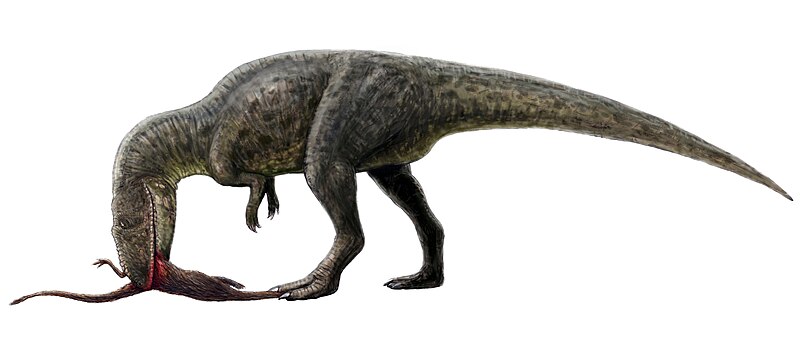Post by dinosauria101 on Aug 5, 2019 17:08:57 GMT 5
Shaochilong maortuensis
Shaochilong (meaning "shark toothed dragon") is a genus of carcharodontosaurid dinosaur from the mid Cretaceous (Turonian stage) Ulansuhai Formation of China (about 92 million years ago). The type species, S. maortuensis, was originally named Chilantaisaurus maortuensis, but was re-described and reclassified in 2009. The holotype, IVPP V2885.1-7, consisting of skull fragments, axis and six caudal vertebrae associated to a single individual is the only known specimen. This specimen was discovered in Outer Mongolia and described by Hu in 1964 as a species of Chilantaisaurus. Chure (2002) and Rauhut (2001) suggested that it did not belong to that genus, and was probably a primitive coelurosaur. However, a re-description by Brusatte and colleagues in 2009 found that it was in fact a carcharodontosaurid, the first recognized from Asia. The genus was originally informally named "Alashansaurus". IVPP V2885.1 was probably adult or nearly adult individual. Its length – based on the length of the maxillary tooth row – is estimated at 6 metres (20 ft). Estimated length of the femur is 61.5 cm, what suggests that whole animal weighted approximately 500 kilograms (1,100 lb).

Utahraptor ostrommaysi
Utahraptor (meaning "Utah's predator" or "Utah thief") is a genus of theropod dinosaurs, including the largest known members of the family Dromaeosauridae. Fossil specimens date to the upper Barremian stage of the early Cretaceous period (in rock strata dated to 126 ± 2.5 million years ago). It contains a single species, Utahraptor ostrommaysorum. The holotype specimen of Utahraptor is fragmentary, consisting of skull fragments, a tibia, claws and some caudal (tail) vertebra. These few elements suggest an animal about twice the size of Deinonychus. Like other dromaeosaurids, Utahraptor had large curved claws on their second toes. One claw specimen is preserved at 22 centimetres (8.7 in) in length and is thought to reach 24 centimetres (9.4 in) restored. The largest described U. ostrommaysorum specimens are estimated to have reached up to 7 m (23 ft) long and somewhat less than 500 kg (1,100 lb) in weight, comparable to a grizzly bear in size. Some undescribed specimens in the BYU collections may have reached up to 11 m (36 ft) long, though these await more detailed study.
:origin()/pre15/b39a/th/pre/i/2017/089/f/9/plunderer_from_utah_by_scotthartman-d2yv4nf.jpg)
Credit to Wikipedia
Shaochilong (meaning "shark toothed dragon") is a genus of carcharodontosaurid dinosaur from the mid Cretaceous (Turonian stage) Ulansuhai Formation of China (about 92 million years ago). The type species, S. maortuensis, was originally named Chilantaisaurus maortuensis, but was re-described and reclassified in 2009. The holotype, IVPP V2885.1-7, consisting of skull fragments, axis and six caudal vertebrae associated to a single individual is the only known specimen. This specimen was discovered in Outer Mongolia and described by Hu in 1964 as a species of Chilantaisaurus. Chure (2002) and Rauhut (2001) suggested that it did not belong to that genus, and was probably a primitive coelurosaur. However, a re-description by Brusatte and colleagues in 2009 found that it was in fact a carcharodontosaurid, the first recognized from Asia. The genus was originally informally named "Alashansaurus". IVPP V2885.1 was probably adult or nearly adult individual. Its length – based on the length of the maxillary tooth row – is estimated at 6 metres (20 ft). Estimated length of the femur is 61.5 cm, what suggests that whole animal weighted approximately 500 kilograms (1,100 lb).

Utahraptor ostrommaysi
Utahraptor (meaning "Utah's predator" or "Utah thief") is a genus of theropod dinosaurs, including the largest known members of the family Dromaeosauridae. Fossil specimens date to the upper Barremian stage of the early Cretaceous period (in rock strata dated to 126 ± 2.5 million years ago). It contains a single species, Utahraptor ostrommaysorum. The holotype specimen of Utahraptor is fragmentary, consisting of skull fragments, a tibia, claws and some caudal (tail) vertebra. These few elements suggest an animal about twice the size of Deinonychus. Like other dromaeosaurids, Utahraptor had large curved claws on their second toes. One claw specimen is preserved at 22 centimetres (8.7 in) in length and is thought to reach 24 centimetres (9.4 in) restored. The largest described U. ostrommaysorum specimens are estimated to have reached up to 7 m (23 ft) long and somewhat less than 500 kg (1,100 lb) in weight, comparable to a grizzly bear in size. Some undescribed specimens in the BYU collections may have reached up to 11 m (36 ft) long, though these await more detailed study.
:origin()/pre15/b39a/th/pre/i/2017/089/f/9/plunderer_from_utah_by_scotthartman-d2yv4nf.jpg)
Credit to Wikipedia


